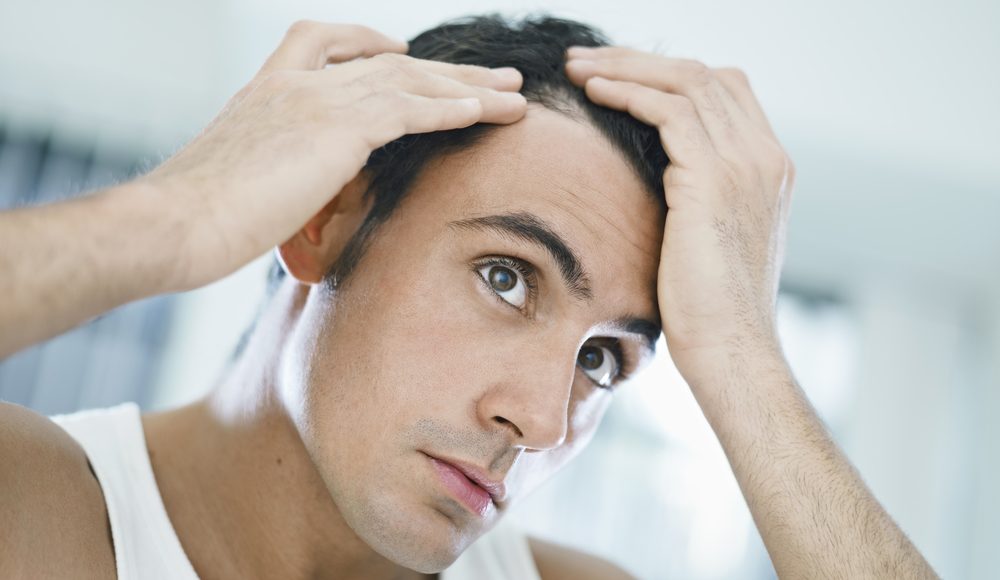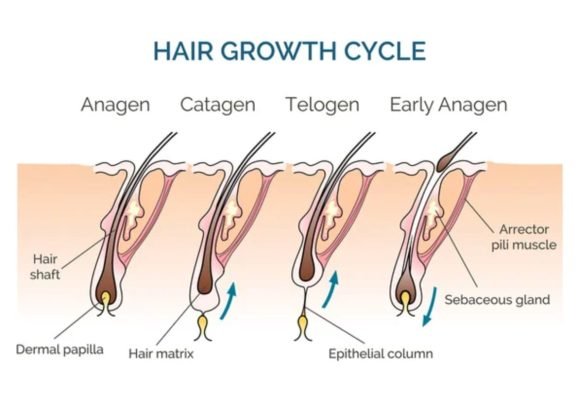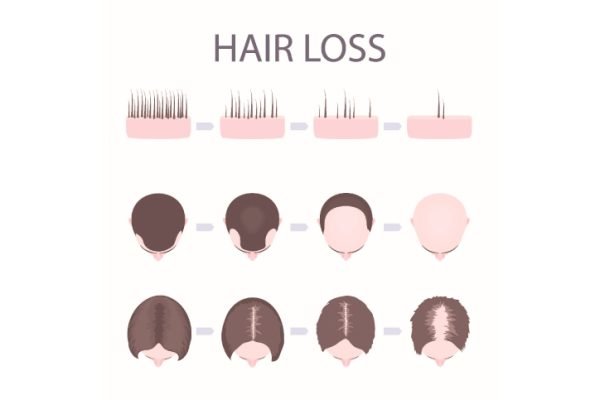Does Minoxidil Work For Hair Loss?
Hair loss affects millions of people worldwide, leading to distress and impacting self-esteem. While various treatments are available, Minoxidil has gained popularity for its effectiveness. This article explores whether Minoxidil works for hair loss, how it functions, its pros and cons and the best practices for usage. If you’re considering Minoxidil for hair growth, read on to find out how it can help you.
What is Minoxidil?
Minoxidil is a topical solution that was initially developed as a medication to treat high blood pressure. In the late 1970s, researchers discovered its unintended side effect: hair growth. This revelation prompted further investigation, leading to its FDA approval as a treatment for androgenetic alopecia (commonly known as male pattern baldness) in 1988.
Minoxidil is available in both over-the-counter and prescription forms. Most users can purchase it without a prescription, making it accessible for those seeking to combat hair loss. The product is typically offered in various formulations, including liquid solutions, foams and sprays, catering to different preferences and ease of application.
How Does Minoxidil Work?
Minoxidil promotes hair growth through a unique mechanism of action. It enhances blood flow to hair follicles, effectively stimulating and revitalizing them. As a result, hair follicles that may have been dormant can enter the anagen phase, which is the growth stage of hair.
Male pattern baldness affects a significant number of men and is characterized by a receding hairline and thinning at the crown. The condition is linked to genetics and hormonal factors, particularly dihydrotestosterone (DHT), which can shrink hair follicles over time. By increasing blood circulation and delivering nutrients to these follicles, Minoxidil helps counteract this shrinkage, potentially leading to new hair growth.
Each hair follicle experiences a cycle that includes growth, resting and eventual shedding, making way for new hair to emerge. Hormonal changes mentioned above disrupt this cycle. However, Minoxidil works to “reset” it, leading to an extended and healthier growth phase, which results in thicker and more robust hair.
Minoxidil for Women
For women, Minoxidil offers a promising solution for hair thinning, especially during and after menopause when hormonal changes can exacerbate hair loss. Women typically experience a more diffuse pattern of hair loss compared to men.
AjantaStore provides Minoxidil in various dosages tailored for women, ensuring that customers can choose the appropriate formulation for their needs. The 2% and 5% solutions are common options, while the spray form offers convenience for targeting larger areas. Using these formulations regularly can help promote thicker and fuller hair, making it easier for women to manage their hair health effectively.
How Effective is Minoxidil?
Minoxidil effectiveness in promoting hair growth is well-documented through various clinical studies.
According to the results of one-year observation study 5% minoxidil solution proved to be effective for hair regrowth in 63% of patients. They applied 1 ml of 5% minoxidil twice a day to hair-loss areas of the scalp.
Most users begin to see noticeable results within four to six months of consistent use. Full effects can take up to a year, as hair growth is a gradual process. However, results can vary depending on individual factors such as age, gender and the extent of hair loss.
It’s important to manage expectations; while many users experience improved hair density, the degree of regrowth, particularly along the hairline, may differ from person to person.
Minoxidil and Finasteride
Finasteride and Minoxidil are two popular treatments for hair loss, but they work through different mechanisms.
- Minoxidil: This topical solution stimulates hair follicles and increases blood flow, promoting hair regrowth.
- Finasteride: Taken orally, finasteride works by blocking the conversion of testosterone to dihydrotestosterone (DHT), the hormone responsible for hair follicle shrinkage.
Combining these treatments can enhance overall effectiveness. For many, using Minoxidil alongside Finasteride results in better outcomes than using either treatment alone. Products like Tricosilk F and Tricosilk Pro are excellent adjuncts to this treatment regimen, providing further nourishment to the scalp and hair follicles.
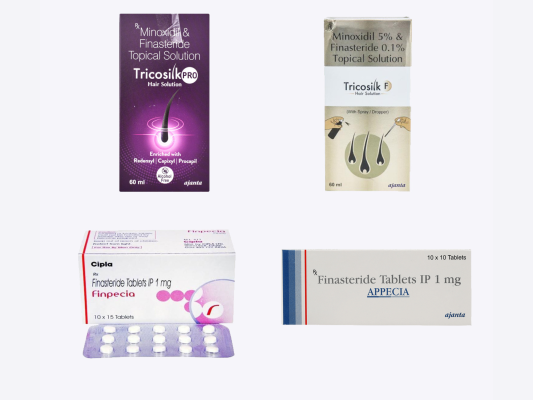
Minoxidil Side Effects
While Minoxidil is generally safe for most users, some may experience side effects. Common side effects include:
- Scalp Irritation: Redness, itching or flaking of the scalp can occur, particularly during the initial weeks of use.
- Unwanted Hair Growth: If the solution drips or spreads to other areas, users may notice hair growth in unintended places.
- Dizziness or Lightheadedness: Though rare, some individuals report feeling dizzy after applying Minoxidil.
- Initial Hair Shedding: Interestingly, new users might notice hair shedding in the early stages of treatment. This shedding can be concerning but is often a sign that the product is working to revitalize hair follicles. As hair follicles shift to the growth phase, the shedding should stabilize.
To explore the various causes of hair loss in men and gain a deeper understanding of male pattern baldness, be sure to read our informative blog post on the topic!
Is Minoxidil Safe?
Minoxidil is generally safe for most individuals when used as directed. However, it’s crucial to consult a healthcare provider if you have underlying health conditions or are taking other medications. Side effects, while uncommon, can occur, and monitoring your body’s response to the treatment is essential.
How to Use Minoxidil
The correct application of Minoxidil is crucial for maximizing its effectiveness in promoting hair growth. Follow these detailed instructions below to ensure optimal results.
Dosages and Formulations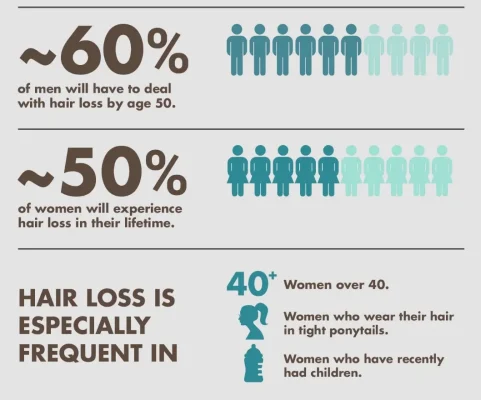
- For Men: 5% Minoxidil Solution or Foam: Apply 1 ml to the affected area of the scalp twice daily (morning and evening).
- For Women: 2% or 5% Minoxidil Solution or Foam: Apply 1 ml to the affected area of the scalp twice daily. Women should generally start with the 2% formulation and may consider moving to the 5% version if they don’t see satisfactory results after several months.
How to Apply Minoxidil: Step-by-Step Instructions
- Preparation: Ensure your scalp is clean and dry before application. Wash your hair with a gentle shampoo and towel-dry it completely.
- Application:
Using the Dropper (for liquid formulations):
- Fill the dropper to the 1 ml mark.
- Part your hair in the area where you want to apply Minoxidil.
- Place the dropper directly on the scalp and squeeze the dropper to release the solution.
- Apply it evenly across the target area, making sure to cover the entire region.
Using the Foam:
- Dispense about half a capful of foam onto your fingers.
- Part your hair and apply the foam directly to the scalp, using your fingers to spread it evenly over the affected area.
- Avoid using too much foam, as a small amount is sufficient.
Using the Spray:
- Hold the spray bottle upright, about 1 to 2 inches away from the affected area of your scalp.
- Part your hair to expose the area where you want to apply Minoxidil.
- Spray the solution directly onto the scalp, using the recommended dosage – typically about 1 ml per application.
- Focus on areas of thinning hair or bald spots, ensuring even coverage.
- After Application:
– Gently massage the solution or foam into the scalp with your fingertips for better absorption.
– Wash your hands thoroughly after applying Minoxidil to prevent unintentional spread to other areas.
Best Time to Use Minoxidil
✓ Consistency is key: Apply Minoxidil twice a day, ideally in the morning and before bedtime. This routine helps maintain stable levels of the medication in your system for optimal results.
✓ Avoid washing hair: After applying Minoxidil, avoid washing your hair or scalp for at least 4 hours to allow for maximum absorption.
Important Tips:
Do not exceed recommended dosage: Using more than the recommended amount will not increase effectiveness and may increase the risk of side effects.
Be patient: It may take 4 to 6 months to start seeing noticeable results, and it can take up to a year for the full effects to manifest.
By following these instructions carefully, you can effectively incorporate Minoxidil into your hair restoration regimen. Always consult a healthcare provider if you have questions or concerns regarding your treatment.
Frequently Asked Questions About Minoxidil
1. Can Minoxidil cause hair loss?
Some users may experience initial hair shedding when starting Minoxidil. This phenomenon, although alarming, is often temporary and indicates that the product is stimulating the hair growth cycle. As new hair begins to grow, it’s not uncommon to notice some shedding of older, weaker hairs. This process is typically a part of the treatment journey, and most users see improvements in hair density over time.
2. Can Minoxidil grow a beard?
Interestingly, Minoxidil has gained attention in the grooming community for its potential to enhance beard growth. Many users have reported success in applying it to the facial area.
3. Can Minoxidil cause brain cancer?
Current research does not support a direct link between Minoxidil and brain cancer. However, it is essential to use it according to guidelines and consult a doctor with any concerns.
4. Can I use Minoxidil once a day?
For best results, Minoxidil is typically recommended for twice-daily application. However, some users may find once-a-day usage convenient. Consistency is key to maximizing results.
5. Does Minoxidil cause weight gain?
Weight gain is not a commonly reported side effect of Minoxidil. However, if you notice unexpected weight changes, consult your healthcare provider.
6. Does Minoxidil have side effects?
Some potential side effects include:
- Scalp Irritation: Redness or itching may occur.
- Unwanted Hair Growth: This may happen if the solution spreads to unintended areas.
- Dizziness or Lightheadedness: Rare, but possible in some individuals.
Minoxidil has proven to be an effective treatment for hair loss, particularly when used consistently over time. Its accessibility and scientific backing make it a go-to choice for many. However, individual results can vary, so it’s crucial to have realistic expectations.
If you’re struggling with hair loss, consider exploring Minoxidil and other alopecia treatments available at Ajanta Store. Our range of products, including Tricosilk F and Tricosilk Pro, can provide additional support for your hair restoration journey. Don’t let hair loss define you – take action today!

